Available filters Toggle display
- Category
- Price
Publications
Need to be tax-exempt?
Contact Laura Tharnish before ordering.
ltharnish2@unl.edu or 402-472-1576
-

Supporting Children of Divorce; Guidelines for Caregivers
$1.00The bond with a caregiver may be the most stable relationship for children whose parents are getting a divorce. The NebGuide discusses how caregivers can help children cope with their emotions during this difficult time. Learn More -
![Supporting Children of Divorce; Guidelines for Caregivers [SPANISH]](https://marketplace.unl.edu/media/catalog/product/cache/7/small_image/223x/9df78eab33525d08d6e5fb8d27136e95/images/catalog/product/placeholder/small_image.jpg)
Supporting Children of Divorce; Guidelines for Caregivers [SPANISH]
$1.00The bond with a caregiver may be the most stable relationship for children whose parents are getting a divorce. The NebGuide discusses how caregivers can help children cope with their emotions during this difficult time. Learn More -
![Survive, Strive, Thrive [Download]](https://marketplace.unl.edu/media/catalog/product/cache/7/small_image/223x/9df78eab33525d08d6e5fb8d27136e95/c/o/copy_of_cover_pages-1.jpg)
Survive, Strive, Thrive [Download]
$35.00Survive, Strive, Thrive: Keys to Healthy Family Living is a 15-unit curriculum that takes teens and adults from day-to-day surviving to thriving at home, at school, at work and in their communities by teaching basic life skills in key areas:
- Goal Setting
- Making Good Decisions
- Self-Esteem
- Coping Skills
- Anger/Conflict Management
- Stress Management
- Building Healthy Relationships
- Developing Good Character
- Communication Skills
- Time Management
- Child Development
- Strong Families
- Positive Parenting
- Money Management
- Creating a Healthy Home
The curriculum includes over 400 pages of easy-to-use lesson plans and handouts developed by University of Nebraska–Lincoln Extension educators with expertise in family life education. Lessons can be completed in 30 minutes and are designed to stand alone or be combined to accommodate longer learning sessions and meet individual needs.
Survive, Strive, Thrive: Keys to Healthy Family Living is a 15-unit curriculum that takes teens and adults from day-to-day surviving to thriving at home, at school, at work and in their communities by teaching basic life skills in key areas:
- Goal Setting
- Making Good Decisions
- Self-Esteem
- Coping Skills
- Anger/Conflict Management
- Stress Management
- Building Healthy Relationships
- Developing Good Character
- Communication Skills
- Time Management
- Child Development
- Strong Families
- Positive Parenting
- Money Management
- Creating a Healthy Home
The curriculum includes over 400 pages of easy-to-use lesson plans and handouts developed by University of Nebraska–Lincoln Extension educators with expertise in family life education. Lessons can be completed in 30 minutes and are designed to stand alone or be combined to accommodate longer learning sessions and meet individual needs.
Learn More -
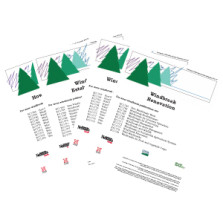
The Basics of Windbreaks
$0.00Windbreaks reduce wind speed and create sheltered zones for growing crops and raising livestock. Windbreaks also protect living and working areas, and provide critical wildlife habitat in a landscape dominated by agricultural crops. This set of four Extension Circulars covers the basics of how windbreaks work, and how to set up, manage and renovate windbreaks.
How Windbreaks Work (EC1763) explains how windbreak structure -- height, density, number of rows, species composition, length, orientation and continuity -- determines how effective the windbreak will be in reducing wind speed and altering microclimate.
Windbreak Establishment (EC1764) contains information on how to plan and establish a windbreak uniquely suited to a particular site, including site preparation, plant material selection, weed control and replanting.
Windbreak Management (EC1768) details how to maintain the health and vigor of a windbreak throughout its life cycle. To-dos include weed control, protection from large animals and rodents, corrective pruning, insect and disease control and property chemical use.
Windbreak Renovation (EC1777) is a step-by-step guide to renovating older or neglected windbreaks to make them functional and effective again. Steps include identifying the primary purpose of the windbreak, evaluating the current condition of the windbreak and implementing suitable renovation techniques.
Format: Two four-page and two six-page Extension Circulars
Learn More -
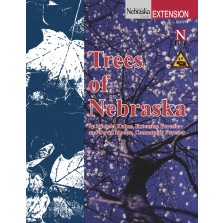
Trees of Nebraska
$1.00Tree planting and care have been important to Nebraskans since the days of J. Sterling Morton, who founded Arbor Day. This 76-page guide includes descriptions and detailed illustrations of identifying characteristics of 97 tree species commonly found in Nebraska. It also includes photos of a number of trees and a dichotomous key to help people identify tree species by comparing leaves, twigs, fruit, bark, and other tree parts.
Co-published with the Nebraska Forest Service.
Learn More -
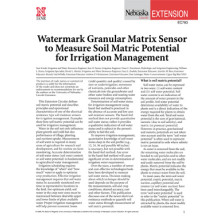
Watermark Granular Matrix Sensor to Measure Soil Matric Potential for Irrigation Management
$0.00This Extension Circular defines soil matric potential and describes principles and operational characteristics of one of the electrical resistance type soil moisture sensors for irrigation management. It also covers basic equipment and installation, soil temperature effects on soil matric potential, system maintenance and trouble shooting. This publication is a valuable reference for growers incorporating this soil water measurement tool into their farming operation. Learn More -
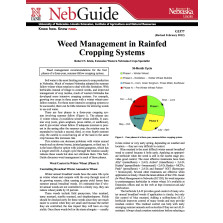
Weed Management in Rainfed Cropping Systems
$1.00Not available online
This four-page NebGuide provides weed management recommendations for the four phases of a three-year, summer-fallow cropping system designed for maximum crop production given limited water availability.
Specific weed management strategies and recommendations are provided for each for the stages:
- Phase I – Winter wheat
- Phase II – Ecofallow in winter wheat stubble
- Phase III – Corn, grain sorghum, proso millet, sunflower
- Phase IV – Pre-winter wheat fallow
-
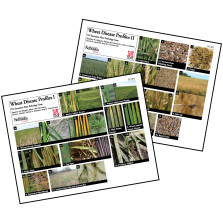
Wheat Disease Profiles
$2.00These Extension Circulars cover a variety of viral, fungal, and bacterial diseases affecting wheat and explain how to manage them.
Wheat Disease Profiles I, EC1873 contains descriptions and photos of wheat diseases, including viral, foliar fungal, and fungal root and crown rot diseases, plus brief management suggestions. Diseases covered include barley yellow dwarf, wheat soilborne mosaic, wheat streak mosaic, high plains disease, wheat spindle streak mosaic, stripe rust, leaf rust, stem rust, tan spot, septoria tritici blotch, common root rot and crown rot, and powdery mildew.
Wheat Disease Profiles II, EC1875 contains descriptions and photos of fungal and bacterial wheat diseases that affect heads and grain and/or leaves, plus brief management suggestions. Diseases covered include loose smut, common bunt (sticking smut), ergot, fusarium head blight (scab), take-all, stagonospora nodorum blotch, bacterial streak and black chaff, cephalosporium stripe, black head molds (sooty head molds), and black point.
Learn More -

Windbreaks and the Environment
$0.00Windbreaks reduce wind speed and create sheltered zones for growing crops and raising livestock. Windbreaks also protect living and working areas, and provide critical wildlife habitat in a landscape dominated by agricultural crops. This set of four Extension Circulars explains how to plant windbreaks to improve the local environment for wildlife, field crops, and fruit and vegetable crops.
Windbreaks and Wildlife (EC1771) provides an overview of how windbreaks can benefit wildlife and what trees, shrubs, and planting designs to consider for various wildlife habitats.
Windbreaks in Sustainable Agricultural Systems (EC1772) contains information on field, livestock, and farmstead windbreaks and how to integrate these with agroforestry practices to create sustainable agricultural systems that enhance the local environment and add profitability.
Field Windbreaks (EC1778) explains how field windbreaks can increase crop yields while reducing inputs and improving both environmental quality and production efficiency.
Windbreaks for Fruit and Vegetable Crops (EC1779) contains information on how wind affects vegetable and fruit crops and how to use windbreaks to improve growing conditions, yield, and quality of fruit and vegetable crops.
Format: One eight-page, one four-page, and two six-page Extension Circulars
Learn More -
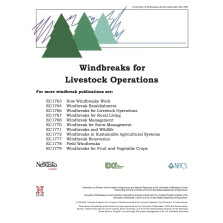
Windbreaks for Livestock Operations
$0.00Windbreaks plan an important role in the protection of livestock, particularly in young animals and in areas with cold northerly winds during the winter and early spring. Properly designed and placed windbreaks can provide benefits to feedlots, liestock pastures, and calving areas. A well-thought-out and properly cared for windbreak protects livestock in both winter and summer.
Time spent on layout, site preparation, weed control, and replanting is paid back many times throughout the life of a windbreak. Topics covered in this guide include:
- Research-based information on how windbreaks benefit livestock, including cattle, swine, and sheep. Covers winter protection, summer protection, snow control, increased yields, working environment, screening unsightly areas, and wildlife habitat
- Designing Your Windbreak
- The Multi-Row Windbreak Design
- The Twin-Row, High-Density Design